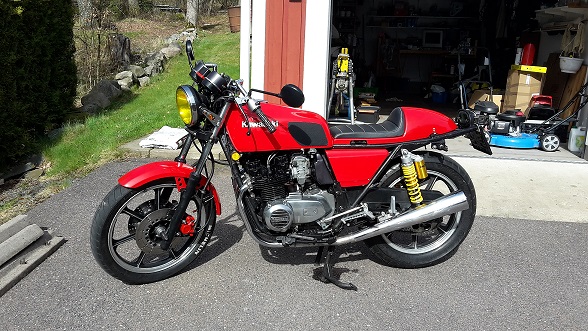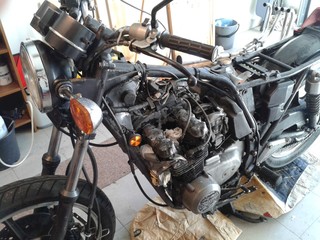Thunberg's
@ Högåsbacke
Motorcycle projects
Kawasaki z400J3 -82 rebuild
 One Kawasaki z400J3
from 1982 was found in a garage just outside Borås in autumn 2013.
The owner said the motor was running ten years ago and then put aside due to the owners health condition.
I filled the chambers with a bit of diesel and tried to start it after charging the battery, it started in a blue cloud....
I bought it for 8 KSEK and planned for a Café racer build.
One Kawasaki z400J3
from 1982 was found in a garage just outside Borås in autumn 2013.
The owner said the motor was running ten years ago and then put aside due to the owners health condition.
I filled the chambers with a bit of diesel and tried to start it after charging the battery, it started in a blue cloud....
I bought it for 8 KSEK and planned for a Café racer build.
The motor was taken a part and cleaned, valves where adjusted, clutch was replaced and sprockets and chain replaced. The fork was reconditioned, brakes reconditioned with new pads and new fluid. New tires and painting of the frame. A complete makeover regarding the electrical system, this was the most time consuming, the 30 year old cables was in a mess and a lot of them needed to be replaced.
In May 2014 it was time for the inspection.
It failed in the first inspection, they found a crack in the frame just beside the footpeg. After some welding to fix it,
we passed the inspection and I was allowed to drive the old lady on the streets. The summer 2014 I was driving it more or less without any
major customization.
The concept of the Z400j follows the theme found in most of the top-selling Japanese motorcycles at the time, the early eighties - an across-the-frame in-line four-cylinder engine mounted in a duplex-cradle chassis.
The Z400J3 is an extremely compact machine with a short wheelbase. It feels small, thanks mainly to a narrow fuel tank and tidy proportions around the side panels that allow the rider to place both feet flat on the ground at traffic stops.
The frame itself appears conventional in that it has a large diameter backbone supporting the steering head. But it is supported above the engine with massive gusset plates which effectively stiffen the front end of the structure. The front fork, a smaller version of the unit found on the big Z1000, appears also to be overly strong with leading-axle sliders with big clamps for the front-wheel spindle. At the rear, the swinging arm pivots on four needle roller bearings.
The stiffness of the front
fork is a real necessity whith a great mesure of travel which have been opted for
along with a steep steering head angle of 64 degrees.
Were it otherwise, the fork would flop around uncontrollably when at full
travel. As it is, it imparts a perceptably high degree of stability in the z400J
that puts it on a par with the best bikes on the road.
Some riders might argue that the
suspension is harsh, and that's certainly true although it's not because of the
spring rates.
Given a lack of stiction in the suspension plus a lighter front rate with more
preload this set-up would work very well, offering a good ride with steadiness
in bends. But the ride feels stiff and is none too mitigated by my hard seat....
Fortunately, nothing is lost in the overall handling. The steering is excellent, being neutral and light to control whether the bike is being weaved through dense traffic or carved through tight bends.
The sintered-pad disc brakes that was found on all the Kawasakis at the time, you have a chassis package that marks high for motorcycles from Japan.
Two thin discs are used at the front with floating calipers while the rear unit is a simple drum brake. Only criticism is of the excessive reach to the front brake handlebar lever.
In performance, the Z400's engine matches the chassis perfectly. Peaking at a claimed 43 bhp at 9,500 rpm with the red line marked at 9,500 rpm, it easily urges the bike to almost 150 Km/h flat out and puts indicated cruising speeds of around 120 Km/h comfortably in the grasp of the rider even when there's only small sections of open road to play with.
Much of the engine's excellent power is derived from the use of double overhead camshafts and the four free-breathing 22mm-choke Tekei carburettors. The crank runs in plain bearings and drive is through a Morse-type chain and gears to the wet clutch. There is the use of another Morse-type chain with an automatic adjuster for driving the camshafts.
Some of the surprising snap throttle response and startling acceleration is derived from the six-speed gearbox and wide ratios. Gear change action is slick and noiseless and the 'box retains the useful neutral-finding dodge that stops you selecting second from bottom at a standstill.
Kawasaki appear to have selected the gear ratios with drag racing in mind for the reve drops between gears are as similar all the way through the range instead of having a large gap between bottom and second and closing up the other ratios. In normal use though the engine is so flexible, pulling cleanly and usefully from as low as 1,000 rpm in top, that the lower ratios hardly ever get used.
The Z400J fires like a cannon from the gate.
With no kickstart lever, it's just
as well the self starter is reliable. The engine fires up cleanly and is helped
on cold mornings by the throttle-valve lifter incorporated into the choke
mechanism. The clutch is annoying though. Like an old english Triumph, it would stick
after being left overnight.
Unfortunately, the worst feature of the mahine is vibration.
When used as a sports bike in the twisties it's doubtful if you'd notice it, but
on motorways the vibes above 5,000 rpm are enough to render the rear-view
mirrors useless.
Otherwise, it is a great little bike, suiting my needs for the fun on the curvy roads close to my home.
Before restoration, 2013 | After rebuild, 2015 |

|

|
Some of the customization:
A lot of pictures was taken during the build, you can watch them all in the album.
